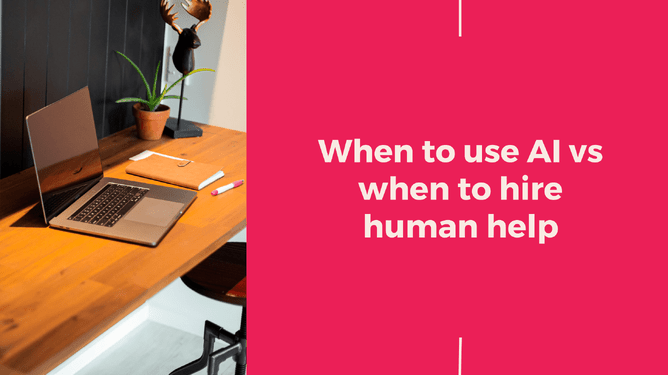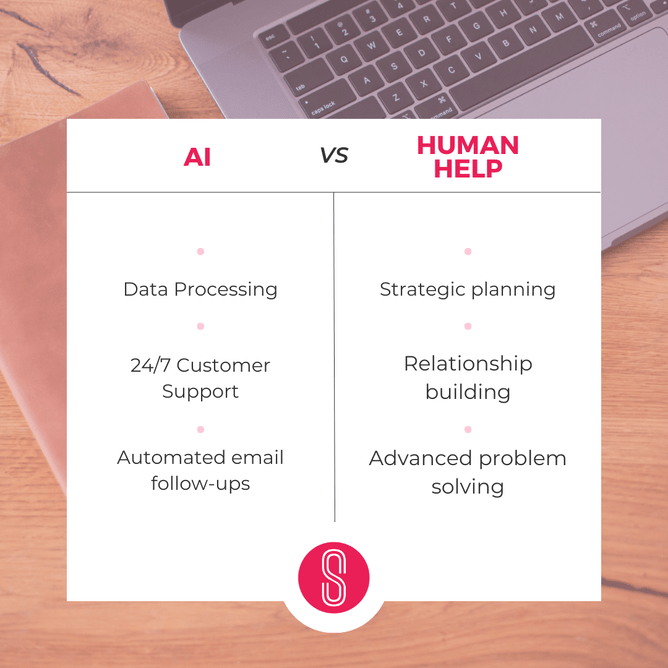As technology advances, business owners are facing a big decision: when to use AI-powered tools and automation, and when to rely on human expertise. While AI can streamline many processes, there are certain areas where a human touch is still irreplaceable.
Finding the perfect balance between AI and human help can boost your efficiency, improve your customer experience, and—most importantly—help your business grow.
In this blog, we’ll break down the strengths and limitations of both AI and human help, and help you find the best mix for your business needs.
AI
Artificial Intelligence (AI) has already transformed the way businesses operate. From handling customer inquiries to automating repetitive tasks, AI solutions can save time, reduce errors, and free up resources for more strategic work.
When to Use AI:
Repetitive, High-Volume Tasks
Tasks like data entry, invoicing, and customer follow-ups are time-consuming but essential. AI can automate these processes, ensuring consistency and accuracy without any human oversight.
Examples: Automated invoice generation, email follow-ups, and website chatbots responding to FAQs.
Data Processing and Analysis
AI thrives on handling large volumes of data quickly and accurately. It can provide insights based on patterns, trends, and predictions far faster than a human could.
Examples: Analytics dashboards, report and graph creation, and data analysis.
Customer Support Outside Business Hours
AI-powered chatbots are perfect for providing round-the-clock customer service. They can handle common inquiries, resolve basic issues, and route more complex requests to a human when necessary.
Examples: Automated customer service chatbots or AI-powered virtual assistants for appointment bookings.
Task Automation and Workflow Management
AI tools like Zapier automate workflows by linking your apps together. If a new customer signs up, for example, you can automatically trigger a series of actions—sending a welcome email, creating a customer profile, and notifying your team.
Examples: Automating lead generation workflows, CRM updates, and email marketing.
When AI Falls Short
While AI can handle repetitive tasks and process data at scale, it’s not without its limitations. Certain areas still require human expertise, emotional intelligence, and creative problem-solving.
Where AI Isn’t Enough:
Complex Decision-Making: AI is great at processing information, but for nuanced decisions, human judgement is still essential.
Personalised Customer Service: While chatbots are perfect for quick fixes, they can’t handle emotionally charged situations or deliver the same level of empathy and understanding as a human.
Strategic Thinking: AI is highly effective in tactical execution, but it can’t replace the strategic insight and creativity of human experts.
Brand Tone and Messaging: AI tools can generate content, but when it comes to capturing the nuances of your brand’s voice and connecting with customers on an emotional level, humans still do it best.
The Human Touch: When to Hire Human Help
Humans bring empathy, creativity, and deep knowledge to the table. While AI handles the repetitive stuff, humans are essential for tasks that require critical thinking, personal interaction, or specialised expertise.
When to Use Human Help:
Strategic Planning and Business Growth
Strategic decisions require an understanding of your business, market conditions, and long-term goals. Human input is necessary to navigate these complex challenges.
Examples: Business growth strategies, marketing campaigns, and project management.
Creative Work
Whether it’s content creation, branding, or design work, creative tasks need a human touch. AI can assist with automation, but it lacks the innovation, emotion, and storytelling ability that make creative work effective.
Examples: Designing marketing campaigns, writing website copy, or developing brand identity.
Relationship Building and Customer Service
Building trust with your clients and customers takes time, effort, and empathy. Humans can adapt to different situations, handle sensitive issues, and deliver personalised service that builds long-lasting relationships.
Examples: Managing client relationships, high-level sales calls, or customer service escalations.
Problem-Solving and Adaptability
AI is built on patterns and algorithms, which makes it less adaptable in unexpected situations. Humans, on the other hand, excel in problem-solving, thinking on their feet, and finding creative solutions to complex problems.
Examples: Handling client issues, developing new service offerings, or dealing with crises.
Finding the Right Balance Between AI and Human Help
So how do you find the perfect mix? It all comes down to understanding the strengths and limitations of both AI and human help, and applying them where they perform best.
Here’s how to strike the right balance:
Automate the Repetitive Tasks
Let AI handle the mundane, repetitive tasks that don’t require human input. Use tools like Zapier, Xero, and automated chatbots to free up time for more valuable work.
Use Human Expertise for Strategy and Creativity
Focus your team’s energy on tasks that require creativity, strategic thinking, and problem-solving. This is where human expertise will deliver the most value.
Use AI to Assist, Not Replace, Human Efforts
AI doesn’t need to replace your human team. Instead, use AI as an assistant—helping to automate the routine tasks so your team can focus on the bigger picture.
Combine AI with Human Support for a Seamless Experience
The most successful businesses use a combination of AI and human help to deliver a seamless customer experience. For example, AI can handle the initial stages of customer support, while human staff can step in for more complex issues.
The key to long-term success lies in finding the perfect balance between AI and human help. When used together, they can boost your efficiency, enhance customer satisfaction, and free up valuable time to focus on growth.
So, don’t think of it as a choice between one or the other. Instead, focus on integrating both AI and human expertise into your business for the best results.
Want to learn more about finding the best support system for your business? Check out Episode 35 of the Get Savvy Podcast or give our Business Support Quiz a try!
Ready to find your perfect support mix? Let’s chat about how AI and human support can work together to take your business to the next level.



